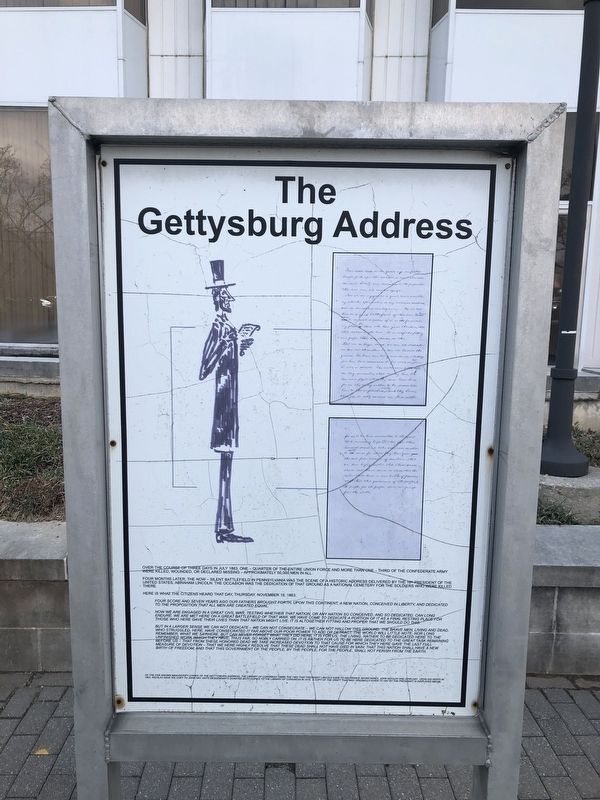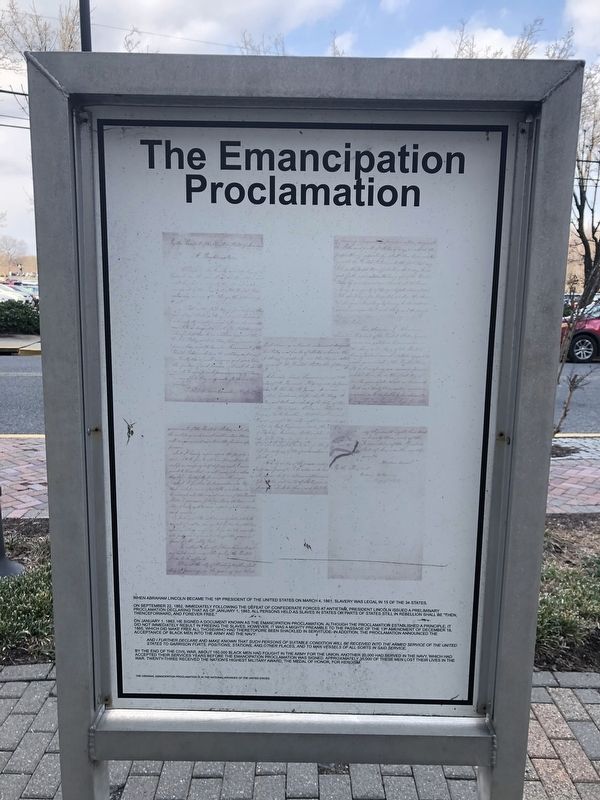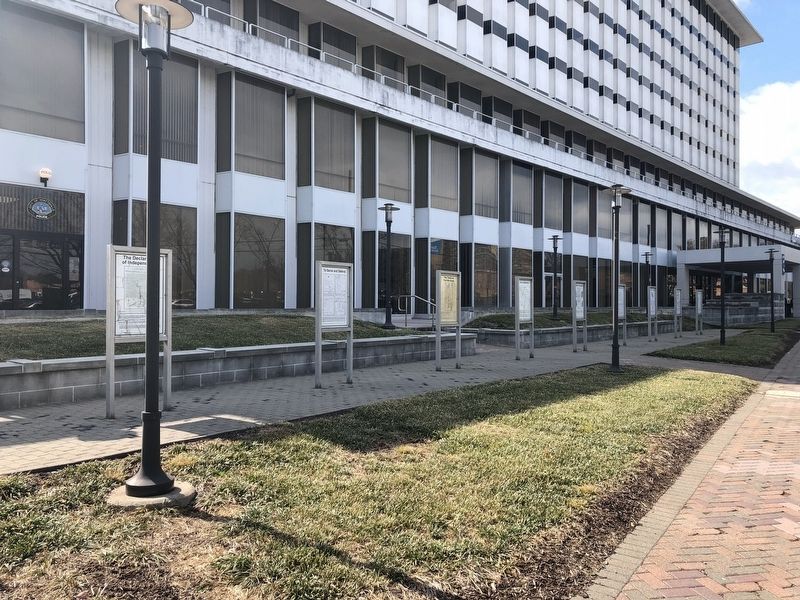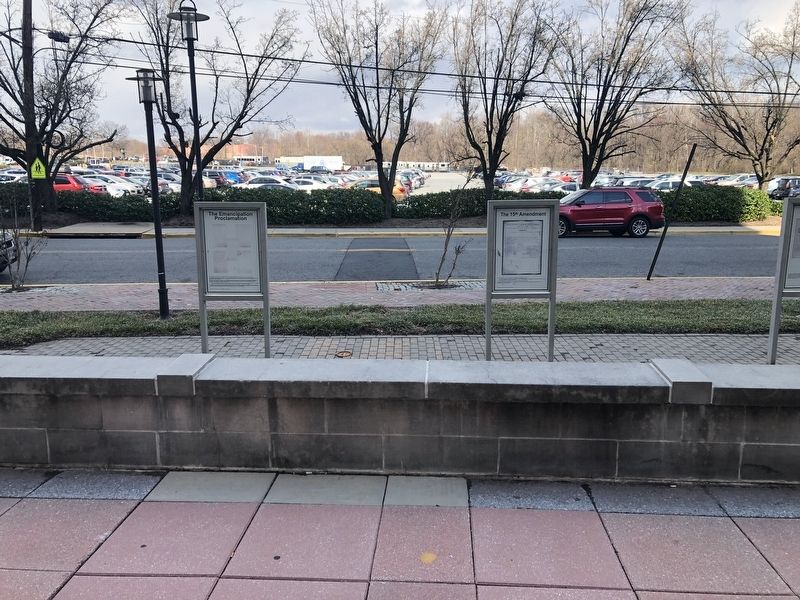Hyattsville in Prince George's County, Maryland — The American Northeast (Mid-Atlantic)
The Gettysburg Address / The Emancipation Proclamation

Photographed By Devry Becker Jones (CC0), February 28, 2020
1. The Gettysburg Address side of the marker
Over the course of three days in July 1863, one-quarter of the entire Union force and more than one-third of the Confederate army were killed, wounded, or declared missing — approximately 50,000 men in all.
Four months later, the now-silent battlefield in Pennsylvania was the scene of a historic address delivered by the 16th President of the United States, Abraham Lincoln. The occasion was the dedication of that ground as a national cemetery for the soldiers who were killed there.
Here is what the citizens heard that day, Thursday, November 19, 1863:
Four score and seven years ago our fathers brought forth, upon this continent, a new nation, conceived in liberty, and dedicated to the proposition that all men are created equal.
Now we are engaged in a great civil war, testing whether that nation, or any nation so conceived, and so dedicated, can long endure. We are met here on a great battlefield of that war. We have come to dedicate a portion of it as a final resting place for those who here gave their lives than that nation might live. It is altogether fitting and proper that we should have to do this.
But in a larger sense we can not dedicate — we can not consecrate — we cannot hallow this ground. The brave men, living and dead, who struggled here, have consecrated it far above our poor power to add or detract. The world will little note, nor long remember what we say here, but can never forget what they did here. It is for us, the living, rather to be dedicated here to the unfinished work which they have, thus far, so nobly carried on. It is rather for us to be here dedicated to the great task of remaining before us — that from these honored dead we take increased devotion to that cause for which they here gave the last full measure of devotion — that we were highly resolve that these dead shall not have died in vain; that this nation shall have a new birth of freedom; and that this government of the people, by the people, for the people, shall not perish from the earth.
Of the five known manuscript copies of the Gettysburg Address, the Library of Congress owns the two that President Lincoln gave to his private secretaries, John Nicolay and John Hay. Upon his death in 1901, Nicolay gave his copy to John Hay. Hay's descendents have donated both copies to the Library of Congress in 1917. A copy of the draft that was originally given to Hay by the President is displayed above.
When Abraham Lincoln became the 16th President of the United States on March 4, 1861, slavery

Photographed By Devry Becker Jones (CC0), February 28, 2020
2. The Emancipation Proclamation side of the marker
On September 22, 1862, immediately following the defeat of Confederate forces at Antietam, President Lincoln issued a preliminary proclamation declaring that as of January 1, 1863, all persons held as slaves in states or parts of states still in rebellion shall be "then, thenceforward, and forever free."
On January 1, 1863, he signed a document known as the Emancipation Proclamation, although the proclamation established a principle, it did not immediately result in freeing the slaves. However, it was a mighty preamble to the passage of the 13th Amendment of December 18, 1865, which did make free all those who had theretofore been shackled in servitude. In addition, the Proclamation announced the acceptance of black men into the Army and the Navy:
And I further declare and make known that such persons of suitable condition will be received into the Armed Forces of the United States to garrison forts, positions, stations, and other places, and to man vessels of all sorts in said service.
By the end of the Civil War, about 160,000 black men had fought in the Army for the Union. Another 20,000 had served in the Navy, which had accepted their services years before the Emancipation Proclamation was signed. Approximately 35,000 of these men lost their lives in the war. Twenty-three

Photographed By Devry Becker Jones (CC0), February 28, 2020
3. The Gettysburg Address / The Emancipation Proclamation Marker
The marker is the rightmost sign.
The original Emancipation Proclamation is in the National Archives of the United States.
Topics and series. This historical marker is listed in these topic lists: African Americans • Civil Rights • War, US Civil. In addition, it is included in the Former U.S. Presidents: #16 Abraham Lincoln, and the Medal of Honor Recipients series lists. A significant historical date for this entry is January 1, 1863.
Location. 38° 58.187′ N, 76° 57.156′ W. Marker is in Hyattsville, Maryland, in Prince George's County. Marker is on Toledo Road just west of America Boulevard, on the left when traveling west. Touch for map. Marker is at or near this postal address: 6525 Belcrest Road, Hyattsville MD 20782, United States of America. Touch for directions.
Other nearby markers. At least 8 other markers are within walking distance of this marker. The Lewis & Clark Expedition / The 15th Amendment (here, next to this marker); The Louisiana Purchase / Edison's Light Bulb Patent (here, next to this marker); The Bill of Rights / The Statue of Liberty (a few steps from this marker); A Nation of Immigrants / The Original 13 States (a few steps from this marker); The Constitution / The 19th Amendment (a few steps from this marker); The Treaty at Fort McIntosh / President Franklin Delano Roosevelt's "Day of Infamy" Address

Photographed By Devry Becker Jones (CC0), February 28, 2020
4. The Gettysburg Address / The Emancipation Proclamation Marker
Marker is on the left.
Credits. This page was last revised on July 23, 2022. It was originally submitted on February 29, 2020, by Devry Becker Jones of Washington, District of Columbia. This page has been viewed 663 times since then and 53 times this year. Last updated on July 23, 2022, by Carl Gordon Moore Jr. of North East, Maryland. Photos: 1, 2, 3, 4. submitted on February 29, 2020, by Devry Becker Jones of Washington, District of Columbia. • J. Makali Bruton was the editor who published this page.